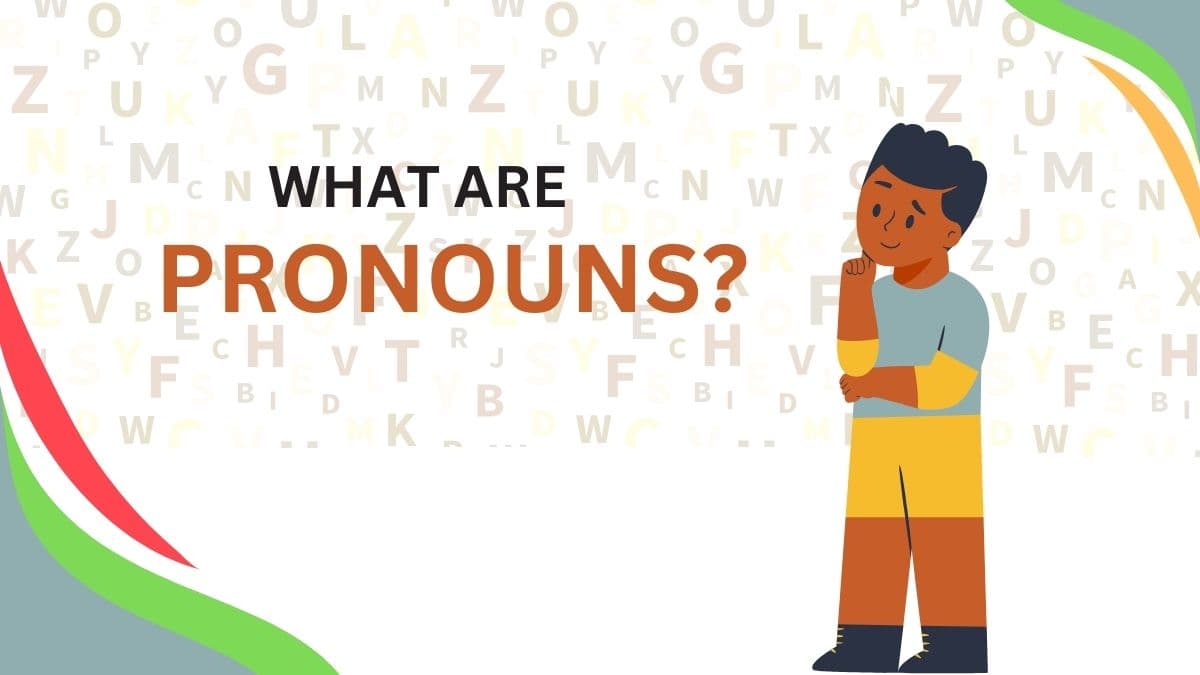What Are Pronouns? A Comprehensive Guide
By Pinkey Sharma |
Date 20-09-2024

Table of Contents
- What is a pronoun?
- Diachronic Development of Pronouns
- Types of Pronouns
- Personal Pronouns
- Reflexive Pronouns
- Demonstrative Pronouns
- Relative Pronouns
- Indefinite Pronouns
- Possessive Pronouns
- Reciprocal Pronouns
- Types of Pronouns
- Subject Pronouns
- Object Pronouns
- Possessive Adjectives
- Intensive Pronouns
- Pronouns for kids
- What Is a Pronoun for Kids?
- Fun Activities to Teach Pronouns to Kids
- Using Pronouns in Sentences
- Common Mistakes to Avoid
- Conclusion
- FAQS
Admissions Open for
Pronouns are very essential elements of the English language. These are the words used in place of nouns to prevent the repetition of similar words and to make the sentences flow smoothly. In this comprehensive guide, we will consider what pronouns are and provide examples. We look at the various types and kinds of pronouns available. Furthermore, we will see how to describe pronouns to kids in a very basic and interesting manner.
What is a pronoun?
A pronoun is used instead of a noun in a sentence. Pronouns avoid the repetition of the same name of the noun in a sentence and, hence, make it less wordy and more readable. For example, rather than saying, "John went to John's house because John forgot John's keys," we would say, "John went to his house because he forgot his keys." Here, "his" is a pronoun that replaces "John's."
Pronouns are definitely an indispensable part of speech in English, and they certainly help us to express ourselves much more effectively. Our sentences would be clumsy and monotonous without pronouns.
Diachronic Development of Pronouns
Pronouns have a very ancient history, dating back to the very early stages of the development of language. Their application can be traced back to ancient languages, in which they played a rather similar role to what they do in making communication easier today. Through the ages, pronouns have changed in form and use to keep up with the dynamics of languages.
In Old English, there were far more forms of personal pronouns than there are today, distinguishing various cases and grammatical genders. For example, the Old English "he" could be "he" (nominative), "hine" (accusative), "his" (genitive), or "him" (dative). Over the next centuries, as the language was being simplified, many of these forms began to drop out of use or merge, ultimately leading to the development of the modern pronoun system used today.
Knowing the history of pronouns can help you appreciate the complexity and importance of pronouns in language.
Types of Pronouns
Pronouns can be classified into various types according to the purpose they fulfill or the manner in which they are used. In the sections, we will look into different types of pronouns with examples on how to use them.
Personal Pronouns
Personal pronouns are the ones that refer either to specific people or things. They are the only type of pronouns that have different forms depending on person, number, and case.
Subjective Case: Used as the subject of a sentence.
Examples: I, you, he, she, it, we, they
Example sentence: She is going to the store.
Objective Case: The direct or indirect object of a verb or preposition.
Examples: me, you, him, her, it, us, them
Example sentence: The teacher called him to the front of the class.
Possessive Case: Used to show ownership or possession.
Examples: my/mine, your/yours, his, her/hers, its, our/ours, their/theirs
Example sentence: That book is hers.
Personal pronouns are important in communication, for they allow referring to people and things without having to repeat the names.
Reflexive Pronouns
Reflexive pronouns are used if the subject is the same person or thing as the sentence's object. They end in "-self" or "-selves.".
Examples: myself, yourself, himself, herself, itself, ourselves, yourselves, themselves
Example sentence: She taught herself to play the piano.
Reflexive pronouns come in very handy in sentences where the subject is performing some action on itself, laying emphasis on the reflexiveness of the action.
Demonstrative Pronouns
Demonstrative pronouns show which things or people are meant. They point out which one(s) the speaker is referring to. Examples: this, that, these, those Example sentence: This is my favorite book. Demonstrative pronouns are therefore useful in identifying and distinguishing a certain thing or things or a particular person or persons, for our language to be exact. 4. Interrogative Pronouns Interrogative pronouns are those used in asking questions. They help form questions about people or things. Examples: who, whom, whose, which, what
Example sentence: Who is coming to the party?
Interrogative pronouns are essential in seeking information and breaking the ice for a conversation.
Relative Pronouns
The relative pronouns introduce relative clauses, which provide more information about a noun in the sentence. They connect the clause to the noun that is explained or described.
Examples: who, whom, whose, which, that
Example sentence: The book that you lent me was interesting.
Relative pronouns add more color to sentences, making our expressions more vivid.
Indefinite Pronouns
Indefinite pronouns are used with reference to nonspecific people or things. They do not point to any particular person or thing. They are often used in generalizing.
Examples: someone, anyone, everyone, no one, nobody, each, few, many, several, all, some
Example sentence: Everyone loved the concert.
The indefinite pronouns enable us to speak generally and often come in handy when we need to state some general statement or make a hypothesis.
Possessive Pronouns
Possessive pronouns show ownership or possession, replacing possessive nouns and indicating that something belongs to someone.
Examples: mine, yours, his, hers, its, ours, theirs
Example sentence: The blue car is mine.
Possessive pronouns are imperative in indicating the relationship between people and their things, thus eliminating the use of too many repeated possessive nouns.
Reciprocal Pronouns
Reciprocal pronouns are used when two or more people are doing something together and, in this case, are involved in an action together that is mutual.
Examples include: each other, one another Example sentence: They did each other's homework. Reciprocal pronouns are particularly useful to describe two people interacting or working with each other.
Types of Pronouns
The types of pronouns can overlap with the categories, but they provide another perspective depending on the specific use in sentences.
Subject Pronouns
Subject pronouns are used as the subject of a sentence. They receive the action of the verb.
Examples: I, you, he, she, it, we, they
Example sentence: We go to the park.
Subject pronouns are very important in the construction of clear and concise sentences, identifying who the performer of an action is.
Object Pronouns
Object pronouns are the objects of a verb or preposition. They receive a verb's action.
Examples: me, you, him, her, it, us, them
Example sentence: The gift was for them.
Object pronouns clarify who or what is the receiver of an action; they complete the clarity of our expressions.
Possessive Adjectives
Possessive adjectives bear a lot of resemblance to possessive pronouns, but they act as adjectives modifying nouns.
Examples: my, your, his, her, its, our, their
Example sentence: Your idea is brilliant.
The possessive adjectives describe the ownership directly in advance of the noun and make it clear and immediate.
Intensive Pronouns
The intensive pronouns emphasize a preceding noun or pronoun. They have the same appearance as reflexive pronouns but differ in function.
Examples: myself, yourself, himself, herself, itself, ourselves, yourselves, themselves
Example sentence: The proposal was passed by the CEO himself.
Intensive pronouns are extremely useful to emphasize or stress that a subject performed an action, indicating that no one else but him or her did the work.
Pronouns for kids
Children can learn pronouns in a very fun and interactive manner. You only need to teach them in simple words with examples that relate to them. Read on to learn how to explain pronouns to your kids:
What Is a Pronoun for Kids?
A pronoun is used to replace a noun—a person, place, or thing—to avoid repeating the noun constantly. For example, instead of saying, "Samantha likes Samantha's toy," we say, "Samantha likes her toy."
Examples of Pronouns for Kids
Personal pronouns: I, you, he, she, it, we, they
Example: He is my friend.
Reflexive Pronouns: myself, yourself, himself, herself, itself, ourselves, yourselves, themselves
Example: She made the cake herself.
Demonstrative Pronouns: this, that, these, and those
Example: This is my favorite book.
Interrogative pronouns: who, whom, whose, which, what
Example: What is your name?
Fun Activities to Teach Pronouns to Kids
Pronoun Matching Game: Prepare two sets of cards, one with the nouns and another with their pronouns. Children can match the noun cards with the correct pronoun cards.
Pronoun Storytelling: Ask children to tell a brief story, and then ask them to substitute the repeated nouns with pronouns. For instance, "Tom has a dog. Tom loves the dog. The dog is Tom's best friend." Children can turn it into, "Tom has a dog. He loves the dog. The dog is his best friend."
Pronoun Craft Make a pronoun wheel where kids can spin and match pronouns with various nouns. For instance, spin to match "he" with "boy," "she" with "girl," etc.
Using Pronouns in Sentences
Helping children use pronouns in sentences is another great way to enhance their understanding. Make sure to practice making sentences together and try to substitute the nouns with pronouns.
Example: "Maria is reading a book. Maria likes the book." becomes "Maria is reading a book. She likes it."
Engage them in fun, interactive, and hands-on exercises so that they can learn without hassle what pronouns are and how they function.
Common Mistakes to Avoid
Even native speakers make some pronounced mistakes at times. Here are some common errors and tips to avoid them:
Mixing up subject and object pronouns
One common mistake is using the wrong form of the pronoun for the subject or object of a sentence.
Wrong: Me and him went to the store.
Right: He and I went to the store.
Remember, subject pronouns are used as the subject of a sentence, while object pronouns are used as the object. .
Using Reflexive Pronouns Incorrectly
Reflexive pronouns should be used only when the subject and the object in a sentence are the same person or thing.
Wrong: Please give it to myself.
Correct: Please give it to me.
Only use reflexive pronouns such as "myself" when referring back to the same subject in the sentence.
Overusing demonstrative pronouns
While demonstrative pronouns are very useful, excessive usage tends to blur the sentences.
Overuse: This is my book. This is my pen. This is my bag.
Improved: This is my book, pen, and bag.
Combine the sentences or use other pronouns instead to avoid repetition for better clarity.
Misused Possessive Pronouns
Possessive pronouns are supposed to replace possessive nouns, not be used along with them.
Incorrect: This is her book.
Correct: This is her book.
Change the position of possessive pronouns in the sentence to avoid redundancy but still show ownership.
Confusing Relative Pronouns
It is often quite confusing to pick the right relative pronoun: who, whom, whose, which, or that.
Incorrect: The person who called me was rude.
Correct: The person who called me was rude.
Use "who" for people, "which" for things, and "that" for either, depending on the context.
Conclusion
Pronouns are an integral part of the English language and definitely make our sentences lucid and succinct. Thus, knowing the different types and kinds of pronouns is essential for perfect communication. Be it writing a complicated essay or explaining the same to kids, having a good idea of how pronouns work will definitely refine your language skills. They range from personal pronouns to indefinite pronouns, and each one serves a specific purpose in our sentences, allowing us to come up with ideas precisely and fluidly.
Pronouns, integrated into your daily usage of a language, can make a huge difference in one's communication skills. Try to practice various types of pronouns in varied situations for comfort in their use. Do activities and exercises that stretch your knowledge about pronouns and their applications. Keep in mind that language is for connecting, and its mastery will help you connect clearly and profoundly with other people.
That will help us not to repeat too much and make speech and writing flow if we use pronouns correctly. Keep in mind that pronouns are substitutes for nouns, so the sentences must be grammatically correct, interesting, and clear to a reader. This guide will be very useful not only for students but also for teachers and self-learners wishing to improve their language skills.
FAQS
What is called a pronoun?
A pronoun is a word that can replace a noun in a sentence. The noun that is replaced by a pronoun is called an antecedent.
What are the 12 pronouns?
In modern English, the personal pronouns include "I," "you," "he," "she," "it," "we," "they," "them," "us," "him," "her," "his," "hers," "its," "theirs," "our," and "your." Personal pronouns are used in statements and commands, but not in questions; interrogative pronouns (like "who," "whom," and "what") are used there.
What are pronouns with meaning?
A pronoun is a word that is used instead of a noun or noun phrase. Pronouns refer to either a noun that has already been mentioned or to a noun that does not need to be named specifically.
We hope you liked the above article. Please do not forget to share this blog with your friends and community members to spread awareness of "What are Pronouns".
CBSE Schools In Popular Cities
- CBSE Schools in Bangalore
- CBSE Schools in Mumbai
- CBSE Schools in Pune
- CBSE Schools in Hyderabad
- CBSE Schools in Chennai
- CBSE Schools in Gurgaon
- CBSE Schools in Kolkata
- CBSE Schools in Indore
- CBSE Schools in Sonipat
- CBSE Schools in Delhi
- CBSE Schools in Rohtak
- CBSE Schools in Bhopal
- CBSE Schools in Aurangabad
- CBSE Schools in Jabalpur
- CBSE Schools in Jaipur
- CBSE Schools in Jodhpur
- CBSE Schools in Nagpur
- CBSE Schools in Ahmednagar
- CBSE School In Tumkur

Call Us to know more about Orchids
Swipe Up

.jpg&w=1920&q=80)














